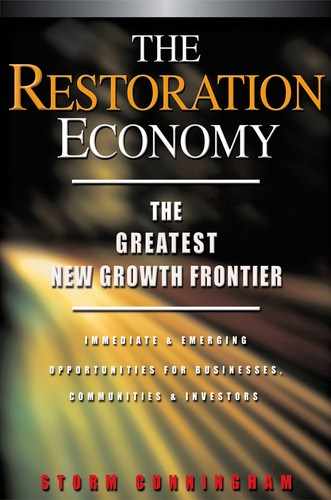Part Two
The Four Growth Industries Restoring Our Natural Environment: Ecosystems, Watersheds, Fisheries, and Farms
Despite Part One’s discussion of theory, history and crises, readers who aren’t economists, historians, or survivalists needn’t worry: The Restoration Economy is not an apocalyptic catalog. Nor is it an academic analysis of the three modes of development. It’s an introduction to the crises that are creating the twenty-first century’s greatest growth frontier, and a business guide to most dynamic mode: restorative development.
The Restoration Economy’s eight restorative industries are divided into two groups, corresponding to the two environments that are being restored: natural and built. None of these industries is purely natural or purely built. For instance, farms primarily affect, and are affected by, the natural environment, but most have significant buildings and infrastructure. Likewise, placing the “brownfields” industry under the “built environment” category reflects its industrial basis (with factory sites, ports, dumps, and other human artifacts being the usual restoration target), but many of these cleanup sites are or will soon again be living ecosystems, with few—if any—structures.
Let’s deal first with the four industries restoring the natural environment. I’ve defined them according to a rather economically driven taxonomy: the restoration of water production, fishing, and farming, plus 54one for all other types of ecosystems. This productivity-based perception is the most natural from the point of view of restorative development.
Throwing “all other ecosystems” together—as I have in the “ecosystem restoration industry” of Chapter 5—is not meant to imply that they are economically less important. These systems directly support fisheries, farms, and watersheds by producing clean air, clean water, and biodiversity. Without these functions, most living systems would soon die.
Many of the ecosystems discussed in Chapters 5, 6, and 7 are located in parks and other protected areas (national, local, and private). They provide recreation-based economic value, which can be both a blessing and a curse for the wildlife.
For example, Smoky Mountain National Park is the most popular (in terms of number of visitors) and the most biologically diverse of the U.S. national parks. In addition to the impact of hikers, campers, and drivers (and the infrastructure that serves them), it must contend with the worst air pollution of our national parks. It has more “dangerous smog” alerts than most large cities, and its rain is strongly acid. The restoration challenge here is more difficult because much of the air pollution is coming from coal-burning power plants hundreds of miles away.
All ecosystems are affected, often catastrophically, by human activities in the built and natural environment around them (even from a great distance). So, please don’t let the chapter structure of this book compartmentalize your thinking about each restorative industry.
All four “natural” restorative industries share some dynamics, such as:
- restoring function(s) to the dysfunctional
- returning something to a previous state
- revitalizing—even resurrecting—the dead and dying
- rehabilitating the damaged or poisoned
Not every project meets all of these criteria, of course, but one dynamic is shared by all: when properly designed and executed, every restoration project will add value without producing a corresponding loss of value or health elsewhere. That is a defining difference between restorative development and new development.
